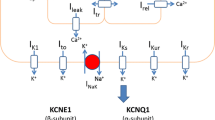Abstract
Atrial fibrillation (AF) is the most common cardiac arrhythmia in the western world. Genetic variants in the cardiac I Kr channel have been identified to influence ventricular repolarization. The aim of this work is to investigate the effect of the mutation N588K on atrial repolarization and the predisposition to AF. Experimental data of N588K mutated hERG channel were incorporated in an atrial ionic model using parameter fitting. The effects of the mutation were analyzed in cell and tissue. N588K showed a gain of function effect, causing a rapid repolarization and a shortening of the action potential duration. Computer simulations of a schematic right atrial geometry were used to investigate the excitation conduction properties. The effective refractory period of mutant cells were reduced from 317 to 233 ms at 1 Hz. The conduction velocity is not significantly influenced by the mutation. Nevertheless, the wavelength of mutant cells is for all frequencies smaller, indicating that the mutation N588K predisposes the initiation and perpetuation of AF.
Preview
Unable to display preview. Download preview PDF.
Similar content being viewed by others
References
Nattel, S.: New ideas about atrial fibrillation 50 years on. Nature 415, 219–226 (2002)
Schimpf, R., Wolpert, C., Gaita, F., Giustetto, C., Borggrefe, M.: Short QT syndrome. Cardiovasc. Res. 67(3), 357–366 (2005)
Cordeiro, J., Brugada, R., Wu, Y., Hong, K., Dumaine, R.: Modulation of I(Kr) inactivation by mutation N588K in KCNH2: a link to arrhythmogenesis in short QT syndrome. Cardiovascular Research 67, 498–509 (2005)
Courtemanche, M., Ramirez, R., Nattel, S.: Ionic mechanisms underlying human atrial action potential properties: Insights from a mathematical model. Am. J. Physiol. 275, 301 (1998)
Seemann, G., Lurz, S., Keller, D., Weiss, D., Scholz, E., Dössel, O.: Adaption of mathematical ion channel models to measured data using the particle swarm optimization. In: IFMBE Proceedings, vol. 22, pp. 2507–2510 (2008)
McPate, M., Duncan, R., Milnes, J., Witchel, H., Hancox, J.: The N588K-HERG K+ channel mutation in the ’short QT syndrome’: mechanism of gain-in-function determined at 37 degrees C. Biochemical and Biophysical Research Communications 334, 441–449 (2005)
Seemann, G., Höper, C., Sachse, F., Dössel, O., Holden, A., Zhang, H.: Heterogeneous three-dimensional anatomical and electrophysiological model of human atria. Phil. Trans. Roy. Soc. A 364, 1465–1481 (2006)
Hodgkin, A.L., Huxley, A.F.: A quantitative description of membrane current and its application to conduction and excitation in nerve. J. Physiol. 177, 500–544 (1952)
Rush, S., Larsen, H.: A practical algorithm for solving dynamic membrane equations. IEEE Trans. Biomed. Eng. 25(4), 389–392 (1978)
Itoh, H., Horie, M., Ito, M., Imoto, K.: Arrhythmogenesis in the short-qt syndrome associated with combined herg channel gating defects: A simulation study. Circulation Journal 70(4), 502–508 (2006)
Weiss, D.L., Seemann, G., Sachse, F.B., Dössel, O.: Modelling of the short QT syndrome in a heterogeneous model of the human ventricular wall. Europace 7S2, 105–117 (2005)
Author information
Authors and Affiliations
Editor information
Editors and Affiliations
Rights and permissions
Copyright information
© 2009 Springer-Verlag Berlin Heidelberg
About this paper
Cite this paper
Seemann, G., Carillo, P., Weiss, D.L., Krueger, M.W., Dössel, O., Scholz, E.P. (2009). Investigating Arrhythmogenic Effects of the hERG Mutation N588K in Virtual Human Atria. In: Ayache, N., Delingette, H., Sermesant, M. (eds) Functional Imaging and Modeling of the Heart. FIMH 2009. Lecture Notes in Computer Science, vol 5528. Springer, Berlin, Heidelberg. https://doi.org/10.1007/978-3-642-01932-6_16
Download citation
DOI: https://doi.org/10.1007/978-3-642-01932-6_16
Publisher Name: Springer, Berlin, Heidelberg
Print ISBN: 978-3-642-01931-9
Online ISBN: 978-3-642-01932-6
eBook Packages: Computer ScienceComputer Science (R0)




